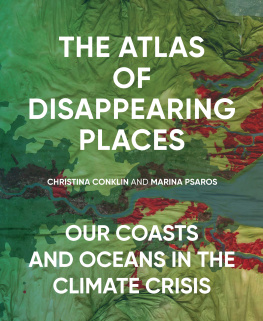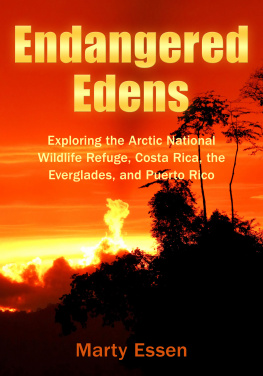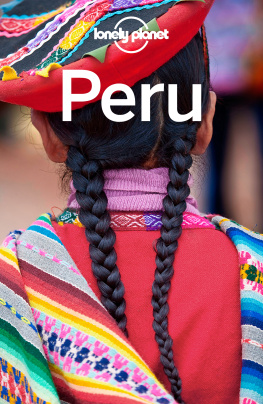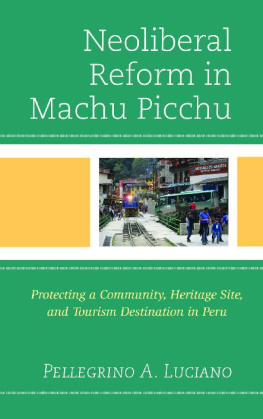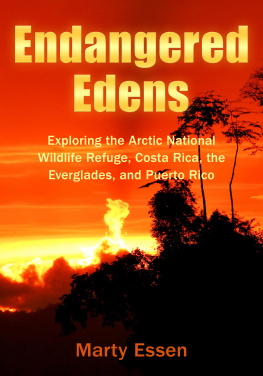
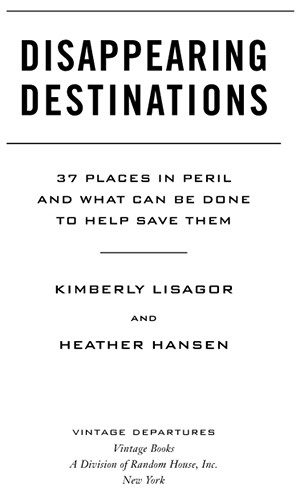
DISAPPEARING
DESTINATIONS
CONTENTS
DEDICATION
For Wes. May the world you'll explore hold more wonders than we can imagine.
For the Baukneys and Hansens, who have always encouraged curiosity and principle.
For the defenders of our wild and sublime places.
A NOTE ON SOURCES
The organizations listed in the appendices are resources for readers who feel moved to act on behalf of these endangered destinations. They are among the hundreds of groups and individuals whose research was invaluable to the writing of this book. Our sources ranged from primatologists thrashing through forests counting apes to Nobel Prizewinning scientists who launched a global call to action by documenting the human causes of climate change. Our observations were built on the framework of their field studies, academic papers, and environmental impact reports. For a complete list of sources, visit endangeredplaces.com.
FOREWORD
PROTECTING THE (GLOBAL) NEIGHBORHOOD
THE IMAGES FLASH PAST ME SOMETIMES, AS THEY DO IN ALL all our inner slide shows, and though, like most slide shows, they bring delight and floods of happy memories, they also bring a certain wistfulness, and unease. I see the winding, lamplit lanes of Kathmandu, when I first viewed them, barely twenty years ago, few motorbikes in sight, and the sight of the nearby mountains radiant. I see the temples of Angkor emerging from the jungle in which they had long been shrouded, and the Taj Mahal on the night I first visited1974when it was possible to enter after nightfall and to see the building by day without a brown shroud of smog. I even sometimes see the town of my birth, Oxford, when it seemed a living historical memory, and not a paved-over Universityland.
When I think of what's being lost in all these places, in only a few years, I realize that some of it is in my head: nowhere looks quite so startling as when first we met it, and for a certain kind of traveler, every change is a change for the worse. In part, perhaps, it's the very interest of people like meour hunger to see the wonders of the worldthat has endangered certain treasures through overcrowding. And yet beneath all the tricks of the imagination, something else is true: many of the marvels of our collective inheritance are disappearing, and because of human neglect or corruption or greed. Kathmandu now is by some counts the second most polluted city in the world. Angkor is the site of frantic construction crews building tourist hotels, which those of us who long to be tourists can hardly deny the locals, so grateful for opportunity after decades of hardship and war. And nearly everywhere that's precious across the world, as Kimberly Lisagor and Heather Hansen show us with such urgency and powerful reporting in these pages, is crying out for help. In our lives the most urgent challenge we face, often, is what we should do with the loved ones who are dying; in our travels the central question is what to do about beloved places that are fading before our eyes.
The first thing we can do, clearly, is to visit them, and the secondalways helped by a visitis to speak up and work for their survival. In a global village in which the treasure of any culture is the blessing of us all, it is our responsibility to protect everywhere, as we would a dying cousin down the road.
I can still remembertoo vividly, perhapsthe first time I set foot in Lhasa, Tibet, in 1985. The Forbidden City, as it's sometimes called, had only just opened up to the world, and the few of us who slipped in saw cultural habits unchanged in centuries. A cluster of whitewashed traditional houses, bright with awnings and flower boxes, sat under the many-windowed Potala Palace, and the sense of an attic door opening was palpable. In all its history, I had read, the heartstopping city had seen fewer than two thousand Westerners (one thousand of them in a single British military expedition). By the time I returned just six years later, the city was under martial law, and there were armed soldiers on the rooftops, surveillance cameras everywhere. By the next time I visited, at the beginning of this century, Lhasa was effectively an Eastern Atlantic City, gaudy with blue-glass shopping centers and high-rises, the Potala not even visible from most places and the few traditional buildings still in evidence referred to as Old Town, as if they belonged to an artificially preserved theme park.
We marvel, rightly, at the acceleration of the new century we're entering, and a sense of speed, of ease and of mobility allows many of us in the privileged world to savor the planet as no generation has done before. Yet the shadow side of all these developments is the speed with which forests and glaciers that took centuries to form are being torn down or allowed to die. And those of us in the privileged world enjoy a particular responsibility that comes with our freedom because we have the potential and means to travel and to help these places, as most of our neighbors on the planet do not. I, on my travels, have often watched cities grow hazy or confused; what Disappearing Destinations shows us, with such richness and intensity, is how the same thing is happening, even more dramatically, to many natural wonders. And no clarity and health will come to the world around us until we start to protect and clear the open spaces of our minds and imaginations, and give globalism a conscience as well as eyes and legs.
All of us have our own examples, of course, and often they begin with our hometowns (Santa Barbara, where I grew up, had never seen generic malls or a smog layer until a few years ago). In Bagan, the heartstopping site of twenty-two hundred templeswhite and earth-red and goldset across the empty plains of Burma, a military dictatorship is busily destroying ancient buildings by restoring them with modern materials, and in nonsensical styles. Mount Everest is so cluttered with visitors and climbers today that traffic jams fill the slopes and what is a sacred presence to the people who live around it is turned into a status-symbol commodity. In Kyoto, near where I now live, a 1,200-year-old city that withstood earthquakes and fires and warsit was even spared American bombs during the Second World Waris falling victim to grasping developers, who are razing centuries-old wooden buildings to make way for multistory, concrete apartment blocks.
As that example bears out, the sudden death of our history comes sometimes from natural causes or old age, but just as often from what we are doing, or failing to do. And what we do, we can potentially not do, or do better. Some sights (like the Buddhas of Bamiyan) are gone forever. Some places (I think of Bali or Beirut) seem permanently about to be spoiled, and yet have outlasted many obituaries. But dozens of others, described so well in these pages, are on the brinkon the equivalent of life-support systemsand it is up to us to mobilize our voices and hearts and energies, in part by remembering that the Yangtze River Valley, the Amazon, and the Great Barrier Reef are all now part of our community, our neighborhood, our backyard. Wake up and act now before the memories you cherish in your mind, and in your inner slide shows, turn into mere elegies, and relics of a world forever gone.
Pico Iyer
Jerusalem
January 2008
Pico Iyer is the author of many books about travel, including Video Night in Kathmandu, The Lady and the Monk, and
Next page



